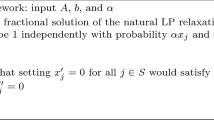Abstract
For a binary integer program (IP) \(\max c^{\mathsf {T}}x, Ax \le b, x \in \{0,1\}^n\), where \(A \in {\mathbb {R}}^{m \times n}\) and \(c \in {\mathbb {R}}^n\) have independent Gaussian entries and the right-hand side \(b \in {\mathbb {R}}^m\) satisfies that its negative coordinates have \(\ell _2\) norm at most n/10, we prove that the gap between the value of the linear programming relaxation and the IP is upper bounded by \({\text {poly}}(m)(\log n)^2 / n\) with probability at least \(1-2/n^7-2^{-{\text {poly}}(m)}\). Our results give a Gaussian analogue of the classical integrality gap result of Dyer and Frieze (Math OR, 1989) in the case of random packing IPs. In constrast to the packing case, our integrality gap depends only polynomially on m instead of exponentially. Building upon recent breakthrough work of Dey, Dubey and Molinaro (SODA, 2021), we show that the integrality gap implies that branch-and-bound requires \(n^{{\text {poly}}(m)}\) time on random Gaussian IPs with good probability, which is polynomial when the number of constraints m is fixed. We derive this result via a novel meta-theorem, which relates the size of branch-and-bound trees and the integrality gap for random logconcave IPs.
Similar content being viewed by others
References
Alon, N., Spencer, J.H.: The Probabilistic Method. John Wiley & Sons, Hoboken (2005)
Beier, R., Vöcking, B.: Probabilistic analysis of knapsack core algorithms. In: Munro, J.I. (ed.) Proceedings of the Fifteenth Annual ACM-SIAM Symposium on Discrete Algorithms, SODA 2004, New Orleans, Louisiana, USA, January 11–14, 2004, pp. 468–477. SIAM (2004)
Borst, S., Dadush, D., Huiberts, S., Tiwari, S.: On the integrality gap of binary integer programs with gaussian data. In: Singh, M., Williamson, D.P. (eds.) Integer Programming and Combinatorial Optimization. Lecture Notes in Computer Science, pp. 427–442. Springer, Cham (2021). https://doi.org/10.1007/978-3-030-73879-2_30
Dadush, D., Huiberts, S.: A friendly smoothed analysis of the simplex method. SIAM J. Comput. 49(5), STOC18–449 (2020). https://doi.org/10.1137/18M1197205
Dey, S.S., Dubey, Y., Molinaro, M.: Branch-and-bound solves random binary IPs in polytime. In: Proceedings of the 2021 ACM-SIAM Symposium on Discrete Algorithms (SODA), pp. 579–591. Society for Industrial and Applied Mathematics (2021). https://doi.org/10.1137/1.9781611976465.35
Dey, S.S., Dubey, Y., Molinaro, M.: Branch-and-bound solves random binary IPs in polytime. arXiv preprint arXiv:2007.15192 (v4) (2021)
Doerr, B.: analyzing randomized search heuristics: tools from probability theory. In: Series on Theoretical Computer Science, pp. 1–20. World Scientific (2011). https://doi.org/10.1142/9789814282673_0001
Dyer, M., Frieze, A.: Probabilistic analysis of the generalised assignment problem. Math. Program. 55(1–3), 169–181 (1992). https://doi.org/10.1007/bf01581197
Dyer, M.E., Frieze, A.M.: Probabilistic analysis of the multidimensional Knapsack problem. Math. OR 14(1), 162–176 (1989). https://doi.org/10.1287/moor.14.1.162
Eisenbrand, F., Weismantel, R.: Proximity results and faster algorithms for integer programming using the Steinitz lemma. ACM Trans. Algorithms 16(1), 1–14 (2020). https://doi.org/10.1145/3340322
Eldar, Y.C., Kutyniok, G. (eds.): Compressed Sensing. Cambridge University Press, Cambridge (2009). https://doi.org/10.1017/cbo9780511794308
Feller, W.: An Introduction to Probability Theory and its Applications, vol. 2. John Wiley & Sons, Hoboken (1991)
Fradelizi, M.: Hyperplane sections of convex bodies in isotropic position. Beiträge Algebra Geom 40(1), 163–183 (1999)
Furst, M.L., Kannan, R.: Succinct certificates for almost all subset sum problems. SIAM J. Comput. 18(3), 550–558 (1989). https://doi.org/10.1137/0218037
Galvin, D.: Three tutorial lectures on entropy and counting. arXiv:1406.7872 [math] (2014)
Goldberg, A.V., Marchetti-Spaccamela, A.: On finding the exact solution of a zero-one knapsack problem. In: Proceedings of the Sixteenth Annual ACM Symposium on Theory of Computing—STOC’84. ACM Press (1984). https://doi.org/10.1145/800057.808701
Jansen, K., Rohwedder, L.: Integer Programming (2019). https://doi.org/10.1002/9781119454816.ch10
Kannan, R.: Minkowski’s convex body theorem and integer programming. Math. OR 12(3), 415–440 (1987). https://doi.org/10.1287/moor.12.3.415
Lenstra, H.W.: Integer programming with a fixed number of variables. Math. OR 8(4), 538–548 (1983). https://doi.org/10.1287/moor.8.4.538
Lovász, L., Vempala, S.: The geometry of logconcave functions and sampling algorithms. Random Struct. Algorithms 30(3), 307–358 (2007). https://doi.org/10.1002/rsa.20135
Lueker, G.S.: On the average difference between the solutions to linear and Integer Knapsack problems. In: Applied Probability-Computer Science: The Interface, vol. 1, pp. 489–504. Birkhäuser, Boston (1982). https://doi.org/10.1007/978-1-4612-5791-2_22
Matousek, J.: Lectures on Discrete Geometry, vol. 212. Springer, New York (2002). https://doi.org/10.1007/978-1-4613-0039-7
Papadimitriou, C.H.: On the complexity of integer programming. J. ACM 28(4), 765–768 (1981). https://doi.org/10.1145/322276.322287
Pataki, G., Tural, M., Wong, E.B.: Basis Reduction and the complexity of branch-and-bound. In: Proceedings of the Twenty-First Annual ACM-SIAM Symposium on Discrete Algorithms, pp. 1254–1261. Society for Industrial and Applied Mathematics (2010). https://doi.org/10.1137/1.9781611973075.100
Prékopa, A.: Logarithmic concave measures with application to stochastic programming. Acta Sci. Math. 32, 301–316 (1971)
Röglin, H., Vöcking, B.: Smoothed analysis of integer programming. Math. Program. 110(1), 21–56 (2007). https://doi.org/10.1007/s10107-006-0055-7
Vershynin, R.: High-dimensional probability: An Introduction with Applications in Data Science. No. 47 in Cambridge Series in Statistical and Probabilistic Mathematics. Cambridge University Press, Cambridge (2018)
Author information
Authors and Affiliations
Corresponding author
Additional information
Publisher's Note
Springer Nature remains neutral with regard to jurisdictional claims in published maps and institutional affiliations.
A preliminary version of this work was published in the proceedings of the 22nd conference on Integer Programming and Combinatorial Optimization (IPCO 2021) [3].
This project has received funding from the European Research Council (ERC) under the European Union’s Horizon 2020 research and innovation programme (grant agreement QIP–805241).
This work was done while the second and third named authors were participating in the Fall 2020 program “Probability, Geometry, and Computation in High Dimensions” at the Simons Institute for the Theory of Computing.
Rights and permissions
About this article
Cite this article
Borst, S., Dadush, D., Huiberts, S. et al. On the integrality gap of binary integer programs with Gaussian data. Math. Program. 197, 1221–1263 (2023). https://doi.org/10.1007/s10107-022-01828-1
Received:
Accepted:
Published:
Issue Date:
DOI: https://doi.org/10.1007/s10107-022-01828-1




